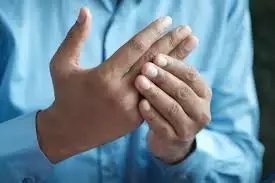- Home
- Medical news & Guidelines
- Anesthesiology
- Cardiology and CTVS
- Critical Care
- Dentistry
- Dermatology
- Diabetes and Endocrinology
- ENT
- Gastroenterology
- Medicine
- Nephrology
- Neurology
- Obstretics-Gynaecology
- Oncology
- Ophthalmology
- Orthopaedics
- Pediatrics-Neonatology
- Psychiatry
- Pulmonology
- Radiology
- Surgery
- Urology
- Laboratory Medicine
- Diet
- Nursing
- Paramedical
- Physiotherapy
- Health news
- Fact Check
- Bone Health Fact Check
- Brain Health Fact Check
- Cancer Related Fact Check
- Child Care Fact Check
- Dental and oral health fact check
- Diabetes and metabolic health fact check
- Diet and Nutrition Fact Check
- Eye and ENT Care Fact Check
- Fitness fact check
- Gut health fact check
- Heart health fact check
- Kidney health fact check
- Medical education fact check
- Men's health fact check
- Respiratory fact check
- Skin and hair care fact check
- Vaccine and Immunization fact check
- Women's health fact check
- AYUSH
- State News
- Andaman and Nicobar Islands
- Andhra Pradesh
- Arunachal Pradesh
- Assam
- Bihar
- Chandigarh
- Chattisgarh
- Dadra and Nagar Haveli
- Daman and Diu
- Delhi
- Goa
- Gujarat
- Haryana
- Himachal Pradesh
- Jammu & Kashmir
- Jharkhand
- Karnataka
- Kerala
- Ladakh
- Lakshadweep
- Madhya Pradesh
- Maharashtra
- Manipur
- Meghalaya
- Mizoram
- Nagaland
- Odisha
- Puducherry
- Punjab
- Rajasthan
- Sikkim
- Tamil Nadu
- Telangana
- Tripura
- Uttar Pradesh
- Uttrakhand
- West Bengal
- Medical Education
- Industry
Expansile lytic lesion of proximal phalanx of hand managed with novel technique: Case study

Expansile lesions in the hand mostly involve phalanges and metacarpals. Among them, majority comprising enchondroma and less incidence of aneurysmal bone cyst, giant cell tumor. The incidence of GCTs of hand bones is reported to be 2%.
Manjunath et al reported a case of 22 year old male graduate presented to outpatient department with complaints of swelling of the right middle finger for 3 months and associated pain for 2 months which gradually progressed, with no constitutional symptoms. Clinically, there was globular swelling of the proximal phalanx, which was tender on palpation and firm in consistency. The active range of motion (ROMs) of the metacarpophalangeal (MCP) joint was restricted, whereas the ROMs of the proximal interphalangeal (PIP) and distal interphalangeal (DIP) joints were preserved. The patient’s capillary refill time was normal with normal distal sensation.
Complete blood counts, erythrocyte sedimentation rate, c reactive protein, and serology were found to be normal. A plain radiograph revealed an expansile lytic lesion with pathological fracture which was suggestive of enchondroma. MRI revealed expansile altered marrow signal intensity involving the proximal phalanx, measuring approximately 3.2 cm × 2.3 cm with no adjacent soft tissue involvement. No periosteal reaction/matrix calcification was found, which favoured enchondroma over the GCT as the probable diagnosis. The lesion appeared hypointense at T1 and hyperintense at T2.Based on clinical observations and radiological findings, enchondroma was considered the most likely diagnosis with the differential diagnosis being GCT, aneurysmal bone cyst.
The lesion was excised en bloc, preserving just the articular surface of the phalanx at the PIP joint. As a cortical breach was present, the A2 pulley was excised. As the tumor appeared benign, reconstruction was performed in the same stage via the nonvascularized proximal phalanx of the 2nd toe graft with A2 pulley reconstruction using the palmaris longus tendon. The MCP joint was a stabilized with single K wire after ligament repair and the PIP joint was stabilized with 2 cross K wires.
Histopathology revealed numerous uniformly scattered osteoclasts, such as giant cells with mononuclear cells in the background, which confirmed the diagnosis of GCT.
The patient was able to perform daily activities at the 10 month follow up with no recurrence of the tumor. He had central slip tightness at PIP joint with restricted flexion at the PIP which improved with central slip tenolysis and PIP arthrolysis. The donor toe healed with fibrosis in the gap and no functional disability or floppiness of the toe is noted. He is comfortable wearing flip flops and able to use the hand for all activities without pain but with minimal stiffness at the PIP joint.
Further reading:
Manjunath N, Reddy DV, Leo L. Expansile lytic lesion of the proximal phalanx of the hand: A diagnostic enigma – A case report on management with a novel technique. J Orthop Trauma Reconstr 2024;1:48-51.
MBBS, Dip. Ortho, DNB ortho, MNAMS
Dr Supreeth D R (MBBS, Dip. Ortho, DNB ortho, MNAMS) is a practicing orthopedician with interest in medical research and publishing articles. He completed MBBS from mysore medical college, dip ortho from Trivandrum medical college and sec. DNB from Manipal Hospital, Bengaluru. He has expirence of 7years in the field of orthopedics. He has presented scientific papers & posters in various state, national and international conferences. His interest in writing articles lead the way to join medical dialogues. He can be contacted at editorial@medicaldialogues.in.


